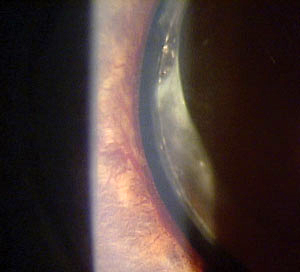 |
|
Patients who were treated for their neovascular glaucoma were assessed one year after treatment, yet no discernable difference in IOP or BCVA was found between the mild-moderate and severe vision loss groups. Photo: Lee Peplinski, OD. Click image to enlarge. |
According to a recent study published in Clinical Ophthalmology, demographic, socioeconomic and clinical factors associated with neovascular glaucoma haven’t been reported on extensively. As a rather severe form of glaucoma, it’s necessary for physicians to recognize the signs and predisposing factors of this ocular disease in their patients. Therefore, researchers from the University of Virginia Health Sciences Center in Charlottesville conducted a study to expand the literature on which factors may contribute to severe vision loss.
The researchers retrospectively evaluated a decade of data on 89 subjects (99 eyes) with neovascular glaucoma and divided them into two groups: mild-moderate vision loss (n=74) and severe vision loss (n=25). Light perception (LP) only vision was the criterion used to distinguish the groups: severe loss = BCVA of LP only; mild-moderate = BCVA >LP.
The study population was made up of 55 white patients, 26 Black patients, 10 Hispanic patients and eight patients who identified as Other. Also, 39 of the subjects were women.
Intraocular pressure and best-corrected visual acuity were assessed between the two groups. Patients with severe vision loss presented with worse BCVA than those in the mild-moderate vision loss group and displayed significantly higher IOP. “On average, patients who progressed to light perception only or no light perception one year after initiating treatment presented with a higher baseline IOP and worse BCVA at diagnosis than those with less severe vision loss,” stated the researchers in their study.
The data suggested that patients who experienced severe vision loss were significantly older than those with mild to moderate vision loss. The average age for a severe case was 71 years old, while mild to moderate cases were diagnosed in patients approximately age 62. Additionally, 68% of female subjects were diagnosed with severe vision loss. No significant difference was reported based on race.
Clinical factors such as hypertension and hyperlipidemia didn’t show a significant association with severe vision loss, but type 2 diabetes displayed a moderate association. Since this study was limited in size, further research would need to be conducted to support the relationship between diabetes and neovascular glaucoma effects.
One additional factor that was analyzed was the impact of insurance on neovascular glaucoma. Researchers found that patients with Medicare or private insurance were less likely to experience severe vision loss compared to those without insurance.
“Additional studies across centers with larger sample sizes are warranted to further investigate and reinforce the relationship between socioeconomic and demographic variables and BCVA outcomes,” concluded the researchers in their study. “Future prospective studies examining more aggressive treatments and lower IOP goals for patients who present with later stages of disease may help guide clinicians in providing individualized care for patients with NVG for more optimized visual outcomes.”
Cotton CC, Goerl BA, Kaplan EF, et al. Demographic, socioeconomic, and clinical factors associated with severe vision loss in patients with neovascular glaucoma. Clinical Ophthalmology 2024;18:2137-45. |


